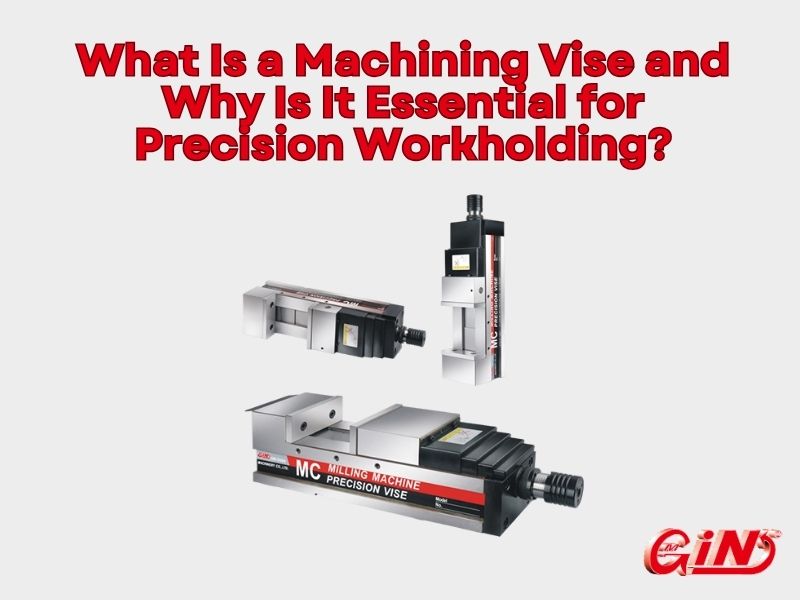2025-05-28
What Is a Machining Vise and Why Is It Essential for Precision Workholding?

In the world of metalworking, CNC machining, and toolmaking, achieving accuracy and repeatability begins with one critical factor—proper workholding. Among the most essential workholding tools used in shops around the world is the machining vise. Whether on a milling machine, CNC center, or manual bench setup, the machining vise plays a central role in securing workpieces for accurate, safe, and efficient machining operations.
This article explores what a machining vise is, the different types available, key features to consider, and how to choose the right one for your shop’s needs.
What Is a Machining Vise?
A machining vise, also known as a milling vise or machine vise, is a mechanical device used to firmly hold a workpiece in place during machining processes such as milling, drilling, grinding, or tapping. It is typically mounted onto a machine table or base and uses a screw or hydraulic mechanism to apply clamping force to the workpiece.
The primary goal of using a machining vise is to prevent movement or vibration during cutting operations, which can lead to dimensional inaccuracies, tool wear, and unsafe working conditions. A quality vise ensures that your workpiece stays secure, flat, and aligned—providing a strong foundation for any high-precision machining task.
Types of Machining Vises
Machining vises come in a variety of types and configurations, each designed to suit specific applications or machine types. Common types include:
1. Standard Milling Vise
This is the most common type of vise found on milling machines. It features a flat base, stationary jaw, and movable jaw operated by a screw handle. Ideal for general-purpose machining tasks.
2. Precision Grinding Vise
Designed for surface grinders, these vises offer extremely high accuracy and parallelism. They are often made of hardened stainless steel and are used for inspecting or grinding ultra-flat surfaces.
3. Self-Centering Vise
This type of vise clamps the workpiece symmetrically from the center outwards, making it ideal for machining round parts or for 4th and 5th axis CNC machines where balance is critical.
4. Hydraulic Vise
Instead of manual clamping, hydraulic vises use pressurized fluid to deliver consistent and strong clamping force with minimal operator effort—perfect for high-volume production environments.
5. Modular or Multi-Station Vise
These vises allow multiple parts to be clamped simultaneously, increasing productivity and reducing setup time in CNC batch processing.
Key Features to Consider
When selecting a machining vise, consider the following features to ensure it matches your machining requirements:
- Clamping Force: The vise must provide enough force to keep the part stable without causing deformation.
- Jaw Width and Opening Capacity: Ensure the jaws can accommodate your part dimensions.
- Accuracy: Look for precision-ground surfaces, tight parallelism, and squareness for high-accuracy work.
- Construction Material: High-quality vises are made of hardened tool steel or cast iron, offering strength and resistance to wear.
- Swivel Base (Optional): Some vises come with a rotatable base for angle machining.
- Repeatability: For batch work or automated CNC setups, the ability to return to exact clamping positions is essential.
Applications of Machining Vises
The versatility of machining vises makes them suitable for a wide range of applications across various industries:
- General Milling: Holding parts securely during face milling, end milling, slotting, or contouring.
- Drilling and Tapping: Preventing part movement under vertical force.
- Precision Grinding: Securing parts flat and square for fine surface finishing.
- CNC Machining Centers: Automating part positioning and quick setups.
- Production Lines: Multi-station vises enable simultaneous machining of multiple parts, boosting efficiency.
Benefits of Using a High-Quality Machining Vise
Investing in a high-quality machining vise is a strategic decision for any manufacturer or job shop. Here are just a few of the benefits:
- Improved Machining Accuracy: Stable workholding leads to better tolerances and surface finishes.
- Increased Safety: A securely clamped part reduces the risk of accidents during cutting.
- Longer Tool Life: Reduced vibration and chatter protect tools from premature wear.
- Faster Setup Times: Reliable positioning and repeatable clamping save time in multi-part runs.
- Greater Productivity: High-performance vises support automation and reduce downtime.
How to Choose the Right Machining Vise
Choosing the right machining vise depends on your specific application, machine type, and production goals. Here are some practical steps:
- Define Your Workpiece Size and Shape – Know the dimensions and geometry of the parts you typically machine.
- Match the Vise to Your Machine – Check the table size, T-slot spacing, and weight capacity of your machine.
- Consider Clamping Method – Decide between manual, pneumatic, or hydraulic operation based on your production volume.
- Evaluate Tolerance Requirements – For high-precision work, choose a vise with certified parallelism and flatness.
- Think Ahead – If you plan to scale up or automate, invest in modular or self-centering vises that support those goals.
Final Thoughts
The machining vise may seem like a simple tool, but it is one of the most important components of a successful machining setup. From hobbyists in small workshops to high-volume production lines, the right vise brings reliability, accuracy, and efficiency to every machining operation.
For manufacturers looking to optimize their CNC machining or manual milling processes, investing in a well-made, properly chosen machining vise is a move that will pay dividends in performance and productivity.
At GIN CHAN Precision Industrial Co., Ltd., we offer a professional range of machining vises engineered for precision, durability, and adaptability. Our vises are designed to meet the needs of modern machining environments—whether you require high clamping force, repeatable accuracy, or compatibility with multi-axis systems.
Explore our full selection of machining vises here:
https://www.gin-chan.com/en-US/pfilter1_14_19-machining-vises
Have questions or need a recommendation for your application?
Contact us today to discuss your machining needs.